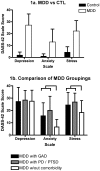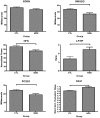Depression, comorbid anxiety disorders, and heart rate variability in physically healthy, unmedicated patients: implications for cardiovascular risk
- PMID: 22355326
- PMCID: PMC3280258
- DOI: 10.1371/journal.pone.0030777
Depression, comorbid anxiety disorders, and heart rate variability in physically healthy, unmedicated patients: implications for cardiovascular risk
Abstract
Context: There is evidence that heart rate variability (HRV) is reduced in major depressive disorder (MDD), although there is debate about whether this effect is caused by medication or the disorder per se. MDD is associated with a two to fourfold increase in the risk of cardiac mortality, and HRV is a robust predictor of cardiac mortality; determining a direct link between HRV and not only MDD, but common comorbid anxiety disorders, will point to psychiatric indicators for cardiovascular risk reduction.
Objective: To determine in physically healthy, unmedicated patients whether (1) HRV is reduced in MDD relative to controls, and (2) HRV reductions are driven by MDD alone, comorbid generalized anxiety disorder (GAD, characterized by anxious anticipation), or comorbid panic and posttraumatic stress disorders (PD/PTSD, characterized by anxious arousal).
Design, setting, and patients: A case-control study in 2006 and 2007 on 73 MDD patients, including 24 without anxiety comorbidity, 24 with GAD, and 14 with PD/PTSD. Seventy-three MDD and 94 healthy age- and sex-matched control participants were recruited from the general community. Participants had no history of drug addiction, alcoholism, brain injury, loss of consciousness, stroke, neurological disorder, or serious medical conditions. There were no significant differences between the four groups in age, gender, BMI, or alcohol use.
Main outcome measures: HRV was calculated from electrocardiography under a standardized short-term resting state condition.
Results: HRV was reduced in MDD relative to controls, an effect associated with a medium effect size. MDD participants with comorbid generalized anxiety disorder displayed the greatest reductions in HRV relative to controls, an effect associated with a large effect size.
Conclusions: Unmedicated, physically healthy MDD patients with and without comorbid anxiety had reduced HRV. Those with comorbid GAD showed the greatest reductions. Implications for cardiovascular risk reduction strategies in otherwise healthy patients with psychiatric illness are discussed.
Conflict of interest statement
Figures




Similar articles
-
Psychophysiological correlates of generalized anxiety disorder with or without comorbid depression.Int J Psychophysiol. 2010 Oct;78(1):35-41. doi: 10.1016/j.ijpsycho.2009.12.016. Epub 2010 Jan 21. Int J Psychophysiol. 2010. PMID: 20093149 Free PMC article. Clinical Trial.
-
Heart rate variability in major depressive disorder and after antidepressant treatment with agomelatine and paroxetine: Findings from the Taiwan Study of Depression and Anxiety (TAISDA).Prog Neuropsychopharmacol Biol Psychiatry. 2016 Jan 4;64:60-7. doi: 10.1016/j.pnpbp.2015.07.007. Epub 2015 Jul 26. Prog Neuropsychopharmacol Biol Psychiatry. 2016. PMID: 26216863 Clinical Trial.
-
Generalized anxiety disorder, comorbid major depression and heart rate variability: a case-control study in taiwan.Psychiatry Investig. 2013 Dec;10(4):326-35. doi: 10.4306/pi.2013.10.4.326. Epub 2013 Dec 16. Psychiatry Investig. 2013. PMID: 24474980 Free PMC article.
-
Heart and soul: heart rate variability and major depression.Behav Pharmacol. 2018 Apr;29(2 and 3-Spec Issue):152-164. doi: 10.1097/FBP.0000000000000387. Behav Pharmacol. 2018. PMID: 29543649 Review.
-
Mind and heart: heart rate variability in major depressive disorder and coronary heart disease - a review and recommendations.Aust N Z J Psychiatry. 2012 Oct;46(10):946-57. doi: 10.1177/0004867412444624. Epub 2012 Apr 23. Aust N Z J Psychiatry. 2012. PMID: 22528974 Review.
Cited by
-
What does Williams syndrome reveal about the determinants of social behavior?Front Hum Neurosci. 2013 Jun 28;7:321. doi: 10.3389/fnhum.2013.00321. Print 2013. Front Hum Neurosci. 2013. PMID: 23825455 Free PMC article.
-
Individual differences in vagal regulation are related to testosterone responses to observed violence.Front Psychol. 2015 Feb 24;6:19. doi: 10.3389/fpsyg.2015.00019. eCollection 2015. Front Psychol. 2015. PMID: 25759673 Free PMC article.
-
Depression in maintenance hemodialysis patients: What do we need to know?Heliyon. 2023 Aug 24;9(9):e19383. doi: 10.1016/j.heliyon.2023.e19383. eCollection 2023 Sep. Heliyon. 2023. PMID: 37662812 Free PMC article. Review.
-
Association and interaction between clinician-rated measures of depression and anxiety with heart rate variability in elderly patients with psychiatric disorders.Heliyon. 2023 Oct 7;9(10):e20740. doi: 10.1016/j.heliyon.2023.e20740. eCollection 2023 Oct. Heliyon. 2023. PMID: 37860509 Free PMC article.
-
Interval Hypoxic Training Enhances Athletic Performance and Does Not Adversely Affect Immune Function in Middle- and Long-Distance Runners.Int J Environ Res Public Health. 2020 Mar 16;17(6):1934. doi: 10.3390/ijerph17061934. Int J Environ Res Public Health. 2020. PMID: 32188027 Free PMC article.
References
-
- Ziegelstein RC. Depression in patients recovering from a myocardial infarction. 2001. pp. 1621–1627. JAMA: The Journal of the American Medical Association. Vol. 286. - PubMed
-
- Nicholson A, Kuper H, Hemingway H. Depression as an aetiologic and prognostic factor in coronary heart disease: a meta-analysis of 6362 events among 146 538 participants in 54 observational studies. Eur Heart J. 2006;27:2763–2774. doi: 10.1093/eurheartj/ehl338. - DOI - PubMed
-
- Barth J, Schumacher M, Herrmann-Lingen C. Depression as a risk factor for mortality in patients with coronary heart disease: a meta-analysis. Psychosom Med. 2004;66:802–813. doi: 10.1097/01.psy.0000146332.53619.b2. - DOI - PubMed
-
- Penninx BW, Beekman AT, Honig A, Deeg DJ, Schoevers RA, et al. Depression and cardiac mortality: results from a community-based longitudinal study. Arch Gen Psychiatry. 2001;58:221–227. - PubMed
-
- Whang W, Kubzansky LD, Kawachi I, Rexrode KM, Kroenke CH, et al. Depression and Risk of Sudden Cardiac Death and Coronary Heart Disease in Women. J Am Coll Cardiol. 2009;53:950–958. doi: 10.1016/j.jacc.2008.10.060. - DOI - PMC - PubMed

